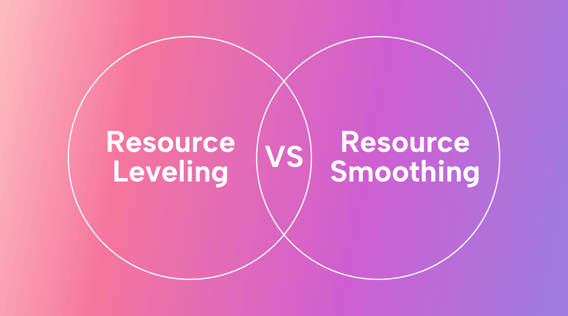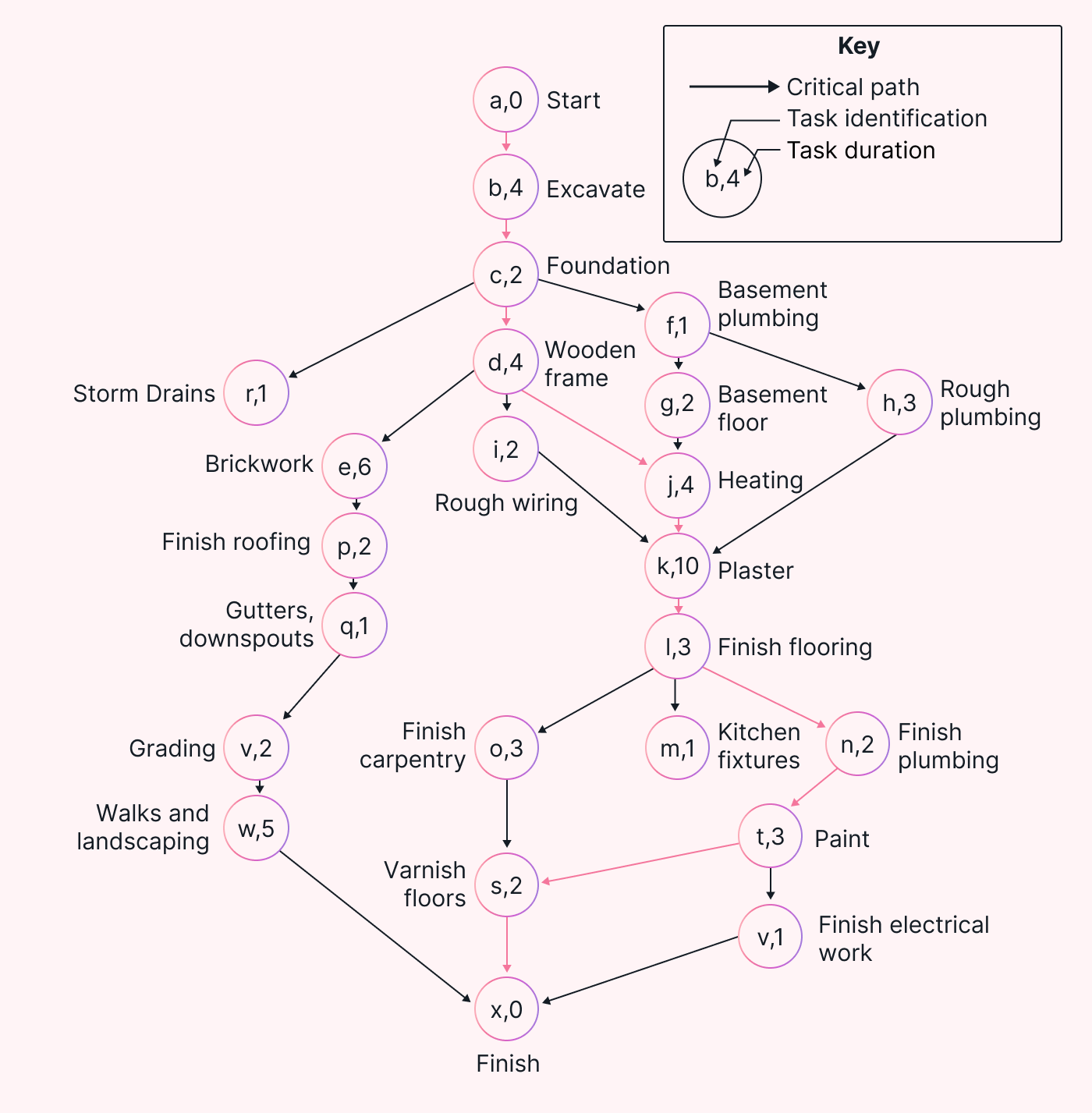In a perfect scenario, you'd have everything you need to take a project from start to finish within the defined time frame. No delays, no time constraints.
But projects rarely work that way. Most project managers will tell you there are always resource constraints and resource conflicts.
So, what can you do when the resource requirements for your project(s) exceed the actual resources you have?
Depending on your specific situation, you might opt for a resource optimization technique. There's resource leveling and resource smoothing.
In plain English, balancing the work with the people doing the work.
In this article, we'll review the two approaches and how they can be used when dealing with limited resources (or a looming due date).
How do you know if you have a resource problem?
Business owners and project managers often struggle with inefficient allocation. It’s tempting to focus your resources on the most critical tasks to complete them on time. But this can cause trouble when you demand more than your resources can produce.
Your resources are everything you need to make things happen, including (though not limited to) your team members, tools and equipment, finances, or the time you invest in projects. And there's never a shortage of demand for resources.
So it's all about the allocation of resources and resource usage.
But if you mismanage your resources, your project or work faces an uphill battle.
According to a 2022 study, 41% of participants identified visibility into the availability of resources as a significant challenge.
To identify a resource problem, it’s important to know which project activities depend on others, creating a chain of dependencies categorized as mandatory (inherent to the project) or discretionary (based on best practices).
Resource allocation becomes a problem when resources are over-allocated or when dependencies (tasks depending on other tasks) create bottlenecks. This issue can lead to delays, burnout, inefficiencies, the possibility of rework, and (thus) additional costs.
Regardless of people or materials, resource leveling is an excellent method to tackle this issue.
What is resource leveling?
Resource leveling is a project management technique to balance resource availability vs. demand. The idea is to maintain a steady, constant level of work without over-usage or under-utilization of a resource.
For example, when a construction worker is assigned tasks which are impossible for them to finish within regular working hours. Instead, the construction project manager extends the project timeline to avoid overburdening the construction team.
Seems easy enough, right? A steady workflow, better quality, improved efficiency and happy workers.
Not so fast, my friends. Extending the project timeline has consequences (including budget implications).
When should you use resource leveling?
Most, if not all, resources are only available in limited quantities. For example, your best designer only has so many hours per week to give.
When those critical resources are over-allocated (i.e., workloads exceed capacity) or under-allocated (i.e., spare time), resource leveling redistributes tasks and timelines so you can hit your project deadlines. It'll also help you maintain the quality of work (and keep the team sane).
Take Susan, for example. She's been running her design agency for a long time now. Through sweat and tears, she's been able to keep her business running. But every time a big project walks in, chaos ensues. Problems pop up, which lead to delays, and the clients become dissatisfied. Ultimately, even Susan wants to throw everything away, move to a beach in Mexico and make a living slinging cocktails.
Her agency isn't the problem. The problem is how she is managing her resources.
She promises her client that the project will be finished in two weeks. Then, she allocates a key employee, Ben, to tasks A and B. To finish the project on time, Ben has to complete both tasks by the first week.
What could go wrong?
Well, first, Ben can't tackle tasks A and B during the same week because each task will take at least a week to finish. Also, what if Ben breaks a leg and is laid up at home for a week? Maybe Susan could finish the tasks, but that'd delay other projects.
This could be solved if Susan would take a step back before agreeing on a deadline. She could move the deadline one week back and tackle tasks A and B sequentially instead of simultaneously.
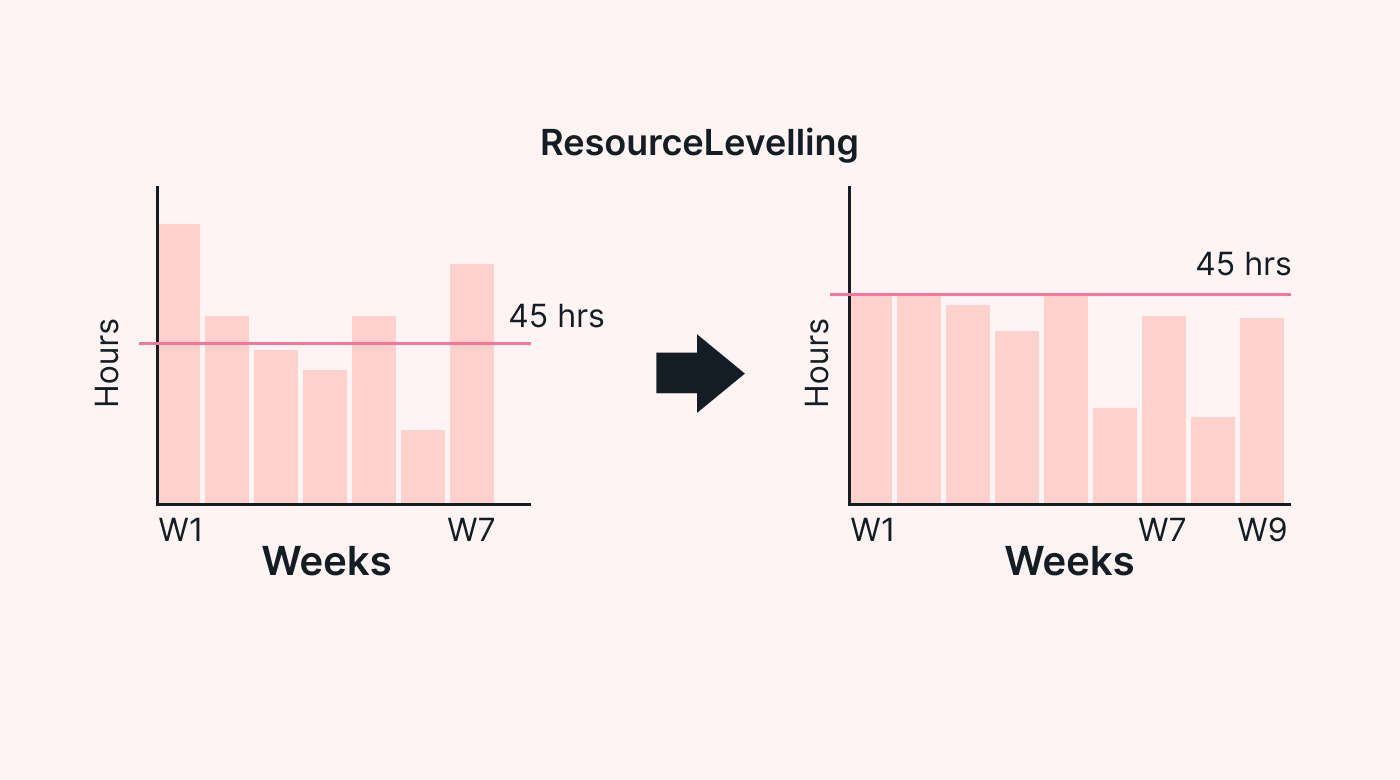 |
Pros of resource leveling
As the focus of leveling is on ensuring the best use of resources, its application has three clear main advantages.
- It maximizes the use of resources while ensuring they're not overloaded. This can prevent burnout and project delays.
- It increases the project's chances of success by balancing workload and resource capacity.
- Under the right circumstances, it can lead to a more streamlined and efficient project timeline, meaning you could deliver high-quality work in a shorter time span.
Cons of resource leveling
However, leveling could produce notable drawbacks when its implementation falls short.
- Often impacts deadlines and overall project scheduling because the process involves redistributing tasks and resources.
- Can highlight areas that may require additional resources, thus a budget adjustment.
- If dependencies aren’t aligned properly, leveling could extend project duration beyond what’s actually required.
What is resource smoothing?
Let's take another example.
Michael owns a wooden toy factory. He's well covered on the resources side for the season. However, he notices something while allocating his people for the season. On weeks 1, 2, and 4, his team will be working at full capacity. For the rest of the weeks, his team will have more than their fair share of spare time.
Michael's plans (and project budgets) will crumble if something unexpected happens.
What to do? Resource smoothing.
Simply put, resource smoothing is a project management technique where you "smooth the terrain." This means distributing the workload over an entire project lifecycle in the most balanced manner possible.
This is a preferable technique when you have resource limitations and the project timeline isn't flexible.
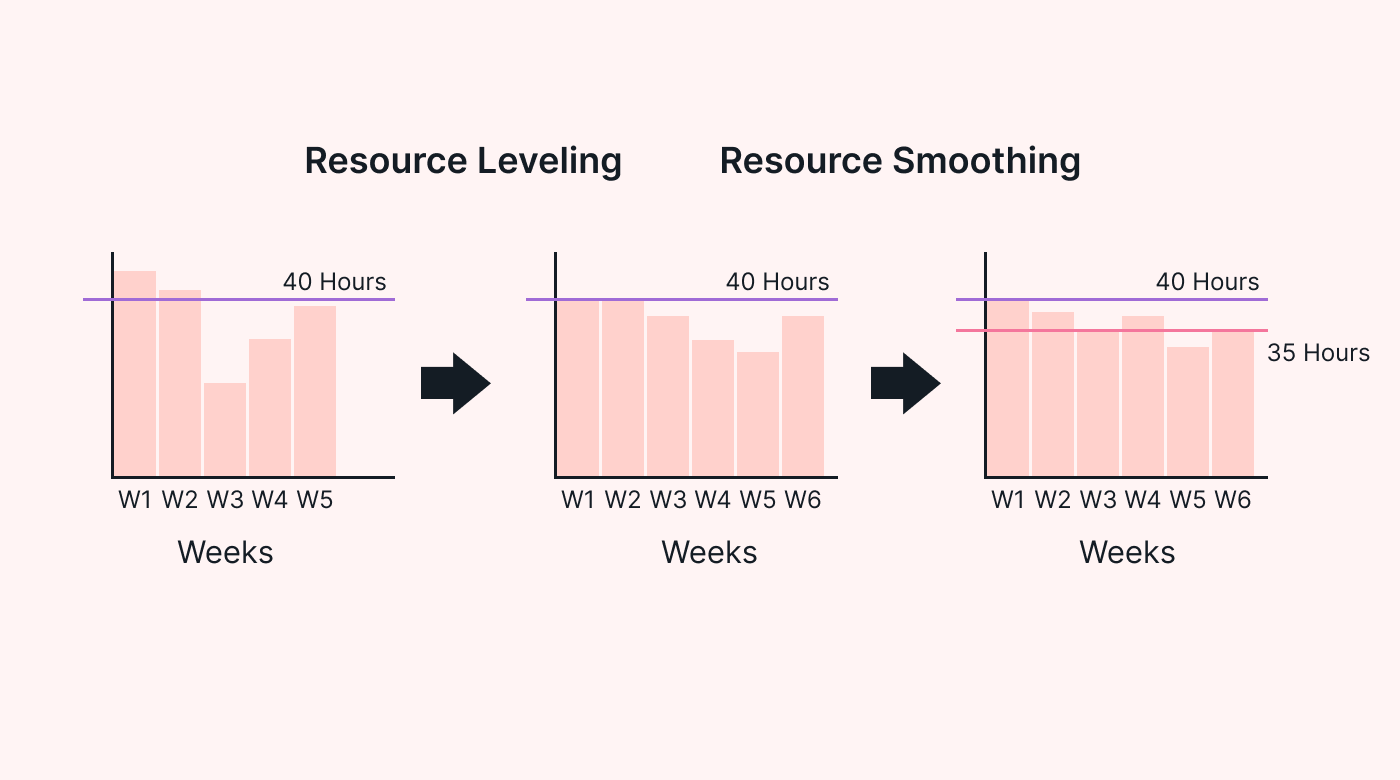 |
Pros of resource smoothing
With resource smoothing, you:
- Avoid work overload or underload among team members.
- Promote a healthier work/life balance for the team.
- Boost job satisfaction, reduce stress, and improve overall team morale.
Cons of resource smoothing
On the flip side, there are some drawbacks to resource smoothing, including:
- Its rigid adherence to deadlines: it can be challenging to implement without impacting scheduled deadlines.
- You might shortchange full resource optimization.
Leveling vs. smoothing, which is better?
Now that we've compared the difference between resource leveling and smoothing, you might wonder which is better.
The good news is that you can use both.
Resource leveling and smoothing differ primarily in their deadlines and allocation approaches. Leveling adjusts the project schedule to match resource availability, potentially extending the timeline, while smoothing works within the existing timeline and redistributing tasks to prevent overloading.
The choice between or for both depends on the project's specific needs and constraints, including deadline rigidity and resource availability.
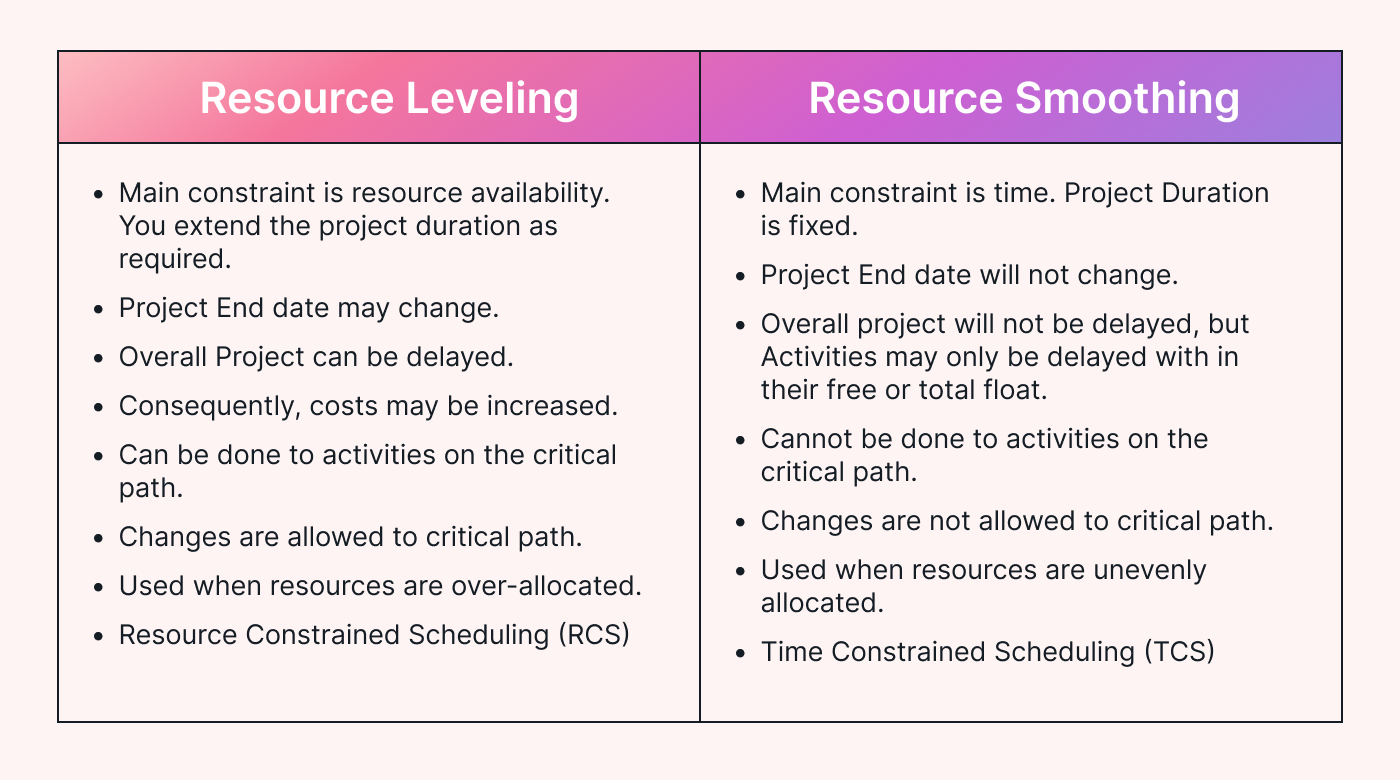 |
Before going further, it's important to mention two project management techniques that also relate to the utilization of resources: fast-tracking and crashing.
While both techniques also deal with resources, they're designed to tackle schedule compression instead of resource optimization. This might be useful if you have to shorten the project timeline (while keeping the original scope of the project).
For example, Michael receives an order of 10,000 toys a week before Christmas when normally he produces 5,000 a week. He could deal with this influx of orders by fast-tracking, allocating resources to tasks simultaneously (when those tasks would normally be tackled sequentially). For example, the toys could be painted and varnished at the same workstation.
Another approach would be crashing, meaning Michael would bring on more resources to finish the work on time.
Both approaches have two likely problems: rework (because, one way or another, you're rushing it) and increased cost.
Three simple tips for better resource management
Start with the critical path
Critical path method (CPM) is a project management technique that, essentially, is the longest sequence of dependent tasks.
In our toy manufacturing example, that means the toys first have to be assembled, then painted, and finally varnished (in that order).
(Here's how to go about defining the critical path.
- Identify all the tasks required to complete your project: Learn about how to do this with a work breakdown structure.
- Identify the interdependence of each task to find out in which order they should be done (best to diagram this out).
- Assign a time frame for each task (leverage your experience, industry norms, or expert assessment).
- Determine the critical path by summing the durations of dependent tasks in this path to calculate the total project duration.
For additional knowledge, check this out: Mastering the critical path method.
Experiment with resource leveling and smoothing
Once you have your critical path, experiment with resource leveling and smoothing by hypothetically applying them to your project schedule.
When you do, are your resources available to complete their tasks? Look for periods in which your resources will be over-allocated or under-utilized. Try rescheduling or delaying those tasks or breaking them into smaller parts.
How does that affect the critical path? The project schedule?
Use project management software
Project management software (like Motion) exists for one primary reason: to make your life easier.
One way they do so is by making task management and resource management more efficient (and less prone to human error).
For example, Motion takes advantage of the inputs you provide to create time blocks for recurring tasks, prioritizes tasks, and even warns you in case it's impossible for you or your team to finish all tasks by the specified deadline.
Forget about the perfect scenario, use Motion instead
Don't wait until everything falls into place. That'll never happen. Instead, create your own path to project success.
Motion is there to help you out.
Motion can help you balance workloads, ensuring no team member is overburdened, and timelines are met.
This advanced project management tool lets you stop worrying about coordinating your team by always letting you know whether you're on track (and reducing the time spent on manual planning).
What are you waiting for? Start exploring Motion with a 7-day free trial.

Josue Valles is a writer with over ten years of experience. He loves simplifying complex topics and sharing his knowledge and insights online.
